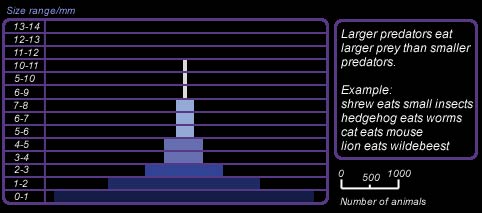Biosphere Contents
4. Interdependence
Various patterns in the abundance of primary producers and consumers have been described, notably Elton's pyramid of numbers
Charles Elton was an undergraduate at Oxford when in 1921 he joined an expedition to the Arctic. The low diversity of animals there (a characteristic feature of high latitude communities) allowed him to produce a food web that included most of the species. He noted a relationship between size and abundance of animals - many small animals and few large ones. The larger animals fed on the smaller ones and so on. He also noted that small animals had shorter generation times and could reproduce faster than larger animals - a "surplus" of small animals which powered the food chain.

The pattern of larger, longer-lived animals feeding on more numerous, smaller animals has important consequences for the distribution of persistent toxins such as pesticide residues within ecological communities. Throughout their lifetimes, predatory birds, for example, continue to accumulate the pesticides contained in each one of their prey items. This biomagnification can result in death or infertility.
What is Elton's pyramid of numbers?